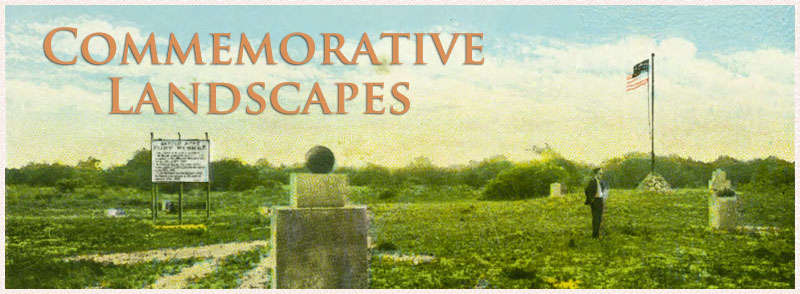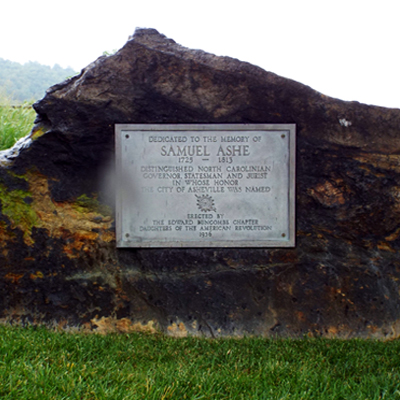
Samuel Ashe Memorial, Asheville
The memorial consists of a rectangular bronze plaque attached to a large irregular shaped boulder standing several feet tall.
DEDICATED TO THE MEMORY OF / SAMUEL ASHE / 1725-1813 / GOVERNOR, STATESMAN AND
JURIST / IN WHOSE HONOR / THE CITY OF ASHEVILLE WAS NAMED /
ERECTED BY / THE EDWARD BUNCOMBE CHAPTER / DAUGHTERS OF THE AMERICAN
REVOLUTION / 1936
Buncombe County
March 5, 1936. Rededication: May 14, 2013
35.595780 , -82.548900
View in Geobrowse
"Ashe Monument," The Historical Marker Database, HMdb.org, (accessed February 20, 2016) Link
"Buncombe County Court House, Asheville, N.C." in Durwood Barbour Collection of North Carolina Postcards (P077), North Carolina Collection Photographic Archives, Wilson Library, UNC-Chapel Hill. Link
Cooper, Max. “Photos: Ashe Memorial Rededication,” Mountain Xpress (Asheville, NC), May 14, 2013, (accessed January 21, 2016) Link
Whiteside, Heustis P. “Ashe, Samuel,” NCPedia.org, (accessed January 21, 2016) Link
“Ashe Honored As D.A.R. Meet In Asheville Ends,” The Daily-Times News, (Burlington, NC), March 5, 1936, 11
Yes
Bronze, stone
Edward Buncombe Chapter Daughters of the American Revolution
The plaque dedication was part of the closing ceremony for the North Carolina Daughters of the
American Revolution annual convention held in Asheville in 1936.
The 2013 rededication ceremony featured the DAR color guard, complete with piccolo and
snare accompaniment. Asheville Mayor Terry Bellamy remarked that she was glad not to be
mayor of “Morristown,” the name by which Asheville was originally known.
In 1797 the small Buncombe County community of Morrisville was incorporated and renamed
Asheville in honor of Samuel Ashe. Ashe was a prominent figure in North Carolina
history leading up to and during the American Revolution.
[Additional information from NCpedia editors at the State Library of North Carolina: This person enslaved and owned other people. Many Black and African people, their descendants, and some others were enslaved in the United States until the Thirteenth Amendment abolished slavery in 1865. It was common for wealthy landowners, entrepreneurs, politicians, institutions, and others to enslave people and use enslaved labor during this period. To read more about the enslavement and transportation of African people to North Carolina, visit https://aahc.nc.gov/programs/africa-carolina-0. To read more about slavery and its history in North Carolina, visit https://www.ncpedia.org/slavery. - Government and Heritage Library, 2023.]
The marker is located southeast of the courthouse, off the Court Plaza and north of Marjorie St. It faces Pack Square Park which is across the street. In the immediate area of the old Buncombe County Courthouse there are other notable plaques, monuments and memorials: Western North Carolina Veterans Memorial, 60th North Carolina Regiment, Revolutionary War, Spanish American and other wars, Police and Firemen who died in the line of duty, and Medal of Honor recipient Lt. Colonel Robert Morgan. Several hundred yards to the west stands the monument to Zebulon Vance and several other small markers.
The marker stands on the grass with a spectacular view of the backdrop of mountains.
 Know anything else about this monument that isn't mentioned here? If you have additional information on
this or any other monument in our collection fill out the form at the Contact Us link in the footer. Thank you.
Know anything else about this monument that isn't mentioned here? If you have additional information on
this or any other monument in our collection fill out the form at the Contact Us link in the footer. Thank you.

